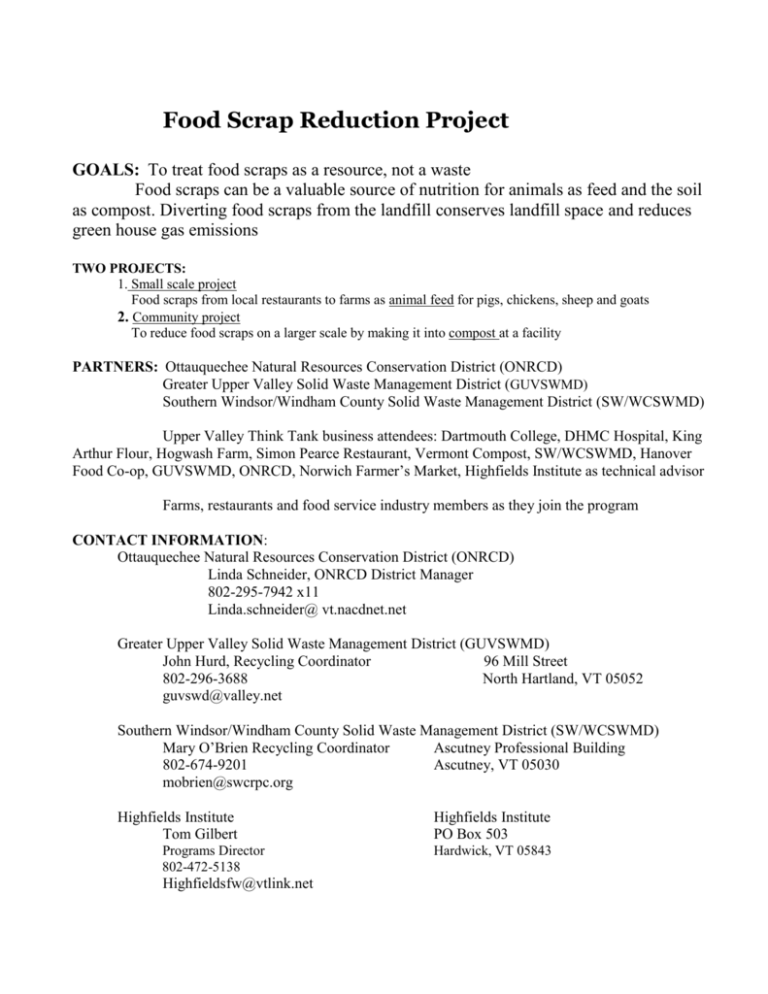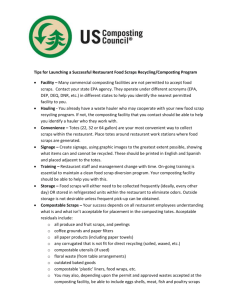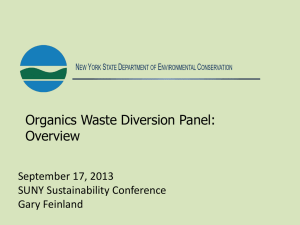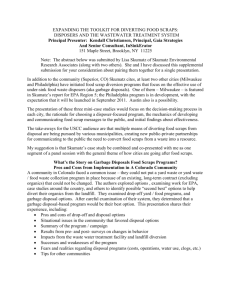Food Scrap Reduction Project - Ottauquechee Natural Resources
advertisement

Food Scrap Reduction Project GOALS: To treat food scraps as a resource, not a waste Food scraps can be a valuable source of nutrition for animals as feed and the soil as compost. Diverting food scraps from the landfill conserves landfill space and reduces green house gas emissions TWO PROJECTS: 1. Small scale project Food scraps from local restaurants to farms as animal feed for pigs, chickens, sheep and goats 2. Community project To reduce food scraps on a larger scale by making it into compost at a facility PARTNERS: Ottauquechee Natural Resources Conservation District (ONRCD) Greater Upper Valley Solid Waste Management District (GUVSWMD) Southern Windsor/Windham County Solid Waste Management District (SW/WCSWMD) Upper Valley Think Tank business attendees: Dartmouth College, DHMC Hospital, King Arthur Flour, Hogwash Farm, Simon Pearce Restaurant, Vermont Compost, SW/WCSWMD, Hanover Food Co-op, GUVSWMD, ONRCD, Norwich Farmer’s Market, Highfields Institute as technical advisor Farms, restaurants and food service industry members as they join the program CONTACT INFORMATION: Ottauquechee Natural Resources Conservation District (ONRCD) Linda Schneider, ONRCD District Manager 802-295-7942 x11 Linda.schneider@ vt.nacdnet.net Greater Upper Valley Solid Waste Management District (GUVSWMD) John Hurd, Recycling Coordinator 96 Mill Street 802-296-3688 North Hartland, VT 05052 guvswd@valley.net Southern Windsor/Windham County Solid Waste Management District (SW/WCSWMD) Mary O’Brien Recycling Coordinator Ascutney Professional Building 802-674-9201 Ascutney, VT 05030 mobrien@swcrpc.org Highfields Institute Tom Gilbert Programs Director 802-472-5138 Highfieldsfw@vtlink.net Highfields Institute PO Box 503 Hardwick, VT 05843 www.highfieldsinstitute.org BRIEF HISTORY OF PROJECTS April 1, 2008 Vermont Organic Recycling Summit Vermont Technical College, Randolph Vermont Afternoon workgroups were set up by geographic area to identify unique community needs and design projects to increase organics recovery. The Upper Valley workgroup, consisting of John Hurd, Linda Schneider, Anton Vicar and Emily Neuman brainstormed food scrap projects. Anton was very clear, he wanted those smelly food scraps to disappear from Simon Pearce Restaurant’s dumpster! Two ideas to explore: 1. Work at an individual level matching food service businesses and farms on a one-on-one basis 2. Work at the community level on a project that would organize organics recovery on a larger scale, perhaps with a centralized composting facility as the destination for materials June 2, 2008 Upper Valley Think Tank meeting USDA Service Center, WRJ Vermont Co-chaired by Linda Schneider, ONRCD District Manager John Hurd, Recycling Coordinator Greater Upper Valley Solid Waste Management District (GUVSWMD) Twelve Attendees from the business and farm community of the Upper Valley: Dartmouth College, DHMC Hospital, King Arthur Flour, Hogwash Farm, Simon Pearce Restaurant, VT Compost, SW/WCSWMD, Hanover Food Co-op, GUVSWMD, ONRCD, Norwich Farmers Market, Highfields Institute as technical advisor Defined goals: 1. Education - provide fact sheets – one for food service businesses interested in organics diversion and one for farmers interested in making use of the organic materials as feed. Fact sheets to be made available on web sites: GUVSWMD, ONRCD, SW/WCSWMD 2. Help generators and farmers connect 3. Organize program, proceed with caution and address regulatory issues 4. Do something at the community level at a later date for composting Also discussed: funding, public awareness program, storage of scraps, summer sawdust and covers on totes, restrictions, regulations, permits and a few other issues SMALL SCALE PROJECT Food scraps from local restaurants to farms as animal feed for pigs, chickens, sheep and goats ADVANTAGES FOR FARMER ADVANTAGES FOR RESTAURANT Lower grain bills Lower dump fees High quality food source of nutrition for livestock Fewer flies at dumpsters Less odor at dumpsters Helping the environment by not filling up the landfills with food scraps SIMPLE GUIDELINES of Small Scale Program Each situation is individual to the farm and the food service establishment. If problems arise, please consider contacting ONRCD to help facilitate. Location is key – the closest proximity will help create success for farmer and restaurant Keeps gas consumption down Convenience is important Pickups may depend on volume – Should be frequent to keep the food scraps fresh Every other day is ideal Seasonal needs may differ Summer – store in cool place Plastic totes should have covers Four inches of sawdust may be necessary Winter – prevent food scraps from freezing Education is key - ONLY FOOD in plastic totes – NO TRASH NO trash means: NO paper, plastic, utensils, stickers, glass…. ANIMALS’ SPECIAL NEEDS MUST BE CONSIDERED All animals are susceptible to salmonella, listeria and e. coli so food scraps must be clean and not rotten. POULTRY CHICKENS egg layers and other meat birds: turkey, duck, quail Chickens can eat most everything, including meat and bones. They love vegetables and breads. One chicken farmer asks that chicken meat and chicken bones be separated out, for fear of cannibalism. PIGS PIGS RAISED FOR HOME USE AND AS PETS Pigs can eat any food item, including bones PIGS THAT WILL BECOME PORK Pre-consumer food scraps do not have to be heat treated. Post consumer food scraps must be boiled before feeding the 'slop' to the pigs, due to two rare diseases transmitted through meat and rodents. SHEEP AND GOATS SHEEP AND GOATS Sheep and goats like all the Cole crops like broccoli, cabbage, kale, Brussells sprouts. Root crops are great like carrots, beets, turnips are great Bread products can be fed. Lettuce is not a favorite and rots quickly. If sheep and goats are being milked, very moldy bread could give a positive antibiotic test because it is really penicillin in there. The cabbage crops can cause the milk to be off-flavor for the following milking. PLASTIC TOTES Totes should have covers to keep flies out and less odors Size of plastic totes – depends on size of food service provider and volume Larger restaurants should consider commercial grade totes with wheels and covers – 55 gallons Smaller food service establishments should consider an appropriate size – Rubbermaid 30 gallons Restaurants should pay for the cost of any plastic totes if they wish to own them Farmer should clean the totes before returning them to the restaurant RESTRICTIONS, REGULATIONS AND PERMITS (Fact sheets from GUVSWD and link) Restaurants should pay for the cost of any necessary permits to help out the farmer (if applicable) SUCCESS STORIES AND STATEMENTS “We have cut our tipping schedule by half. Last year we emptied the dumpster twice a week, now we are down to once a week because our food scraps are being fed to local pigs,” food store in Woodstock, Vermont “My chickens eat better than I do, I can smell the freshness,” Hartland farmer “With the high cost of grain, this program just makes good sense,” pig owner in Taftsville, Vermont FIRST SUCCESS STORY Anton Vicar, General Manager of Simon Pearce Restaurant wanted a way to get the smelly food scraps out of the dumpster. He was very clear at the April 1, 2008 meeting of Vermont Organic Recycling Summit. As he connected with the right people, his dream was realized. Linda Schneider, District Manager at Ottauquechee Natural Resources Conservation District made the connection to Rocky Ridge Farm of Hartland. Sharon and Lester Blake have 800 chickens to feed daily. Grain prices are rising and chickens love to eat food scraps. In the summer, Lester goes every other day to pick up 55 gallons of food scraps from Simon Pearce Restaurant to feed to the chickens and he delivers farm fresh free-range local eggs to the restaurant. Sharon does not want any chicken or chicken bones in the food scraps, hoping to prevent cannibalism. The food scraps are of high nutritional value for the chickens and keep the grain costs down for the farmer. This is a win-win situation. Simon Pearce Restaurant is saving tipping fees, has fewer flies and less odor from the dumpster. Anton said, “The only thing that could make this a sweeter deal was if the farmer also wanted to take the used oil for biofuel.” COMMUNITY PROJECT Goal: To reduce food scraps on a larger scale by making it into compost at a facility NO PROGRESS YET. Waiting some new legislation.






